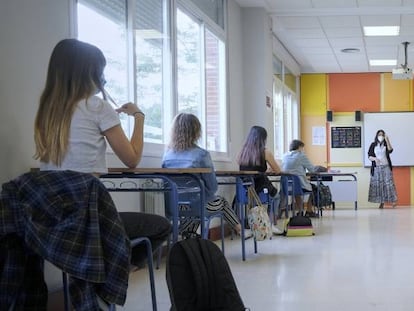Spanish government, regions agree that children over age of six will have to wear masks in schools
Under the plans drawn up by the Health Ministry, and which are being finalized today, education centers will only close if coronavirus transmission becomes uncontrolled, with quarantines for ‘bubble’ groups if cases are detected in students or staff
Schools in Spain will only close temporarily if the coronavirus spreads through students and staff in a generalized way after they reopen for the new school year this September. That’s according to the protocol that has been put together by the central Health Ministry and that is being debated today by the central government and the country’s autonomous regions, who have powers over education and healthcare, among other areas.
The plan is to create “bubbles” of students, who will not interact with other classes nor take part in activities where they mix outside their groups. This will allow schools to remain open even if outbreaks occur, according to the plan, which was published today by Spanish daily La Razón.
The text also sets out that all members of a bubble group, will have to undergo quarantine should a coronavirus infection be detected. At the meeting on Thursday, the Health Ministry and regional authorities agreed that all students above the age of six will have to wear a face mask in class even if they are within a bubble group, according to sources present at the gathering.
The protocol could still be modified, and each region will be able to adapt the guidelines as they see fit
The protocol could still be modified, and each region will be able to adapt the guidelines as they see fit. But the broad strokes of the plan will be followed by schools in the case of positive cases.
The text sets out “three possible scenarios” according to the severity of the spread of the virus.” The first refers to the existence of “isolated outbreaks or sporadic cases,” which will be dealt with via “the habitual control measures: isolation of cases and identification and quarantine of contacts” within each bubble group.
If the situation is complicated due to “complex outbreaks or sporadic community transmission,” the second scenario will be brought into play. In this event, “the chains of transmission cannot easily be identified or appear in different branches, with more than one generation of cases,” affecting more than one bubble. To stop the spread of the virus in these cases, the closure of some classes will be considered, while the circle of contacts who must go into quarantine will be widened.
The third scenario involves “uncontrolled community transmission” of the virus in the school, with a large number of cases. In these situations, “regional public health services will carry out a risk evaluation to consider the need to scale up measures, including as a last resort the temporary closure of the education center.”
The protocol insists that children and teaching staff who present symptoms compatible with the coronavirus must not go to their schools under any circumstance and should stay at home. Should the symptoms begin while on the premises, the suspected cases should wear a surgical mask, and be transferred to a separate area. Family members will be notified, as well as the person responsible for managing the coronavirus situation in each school.
Suspected cases will have to remain isolated in their homes while PCR tests are carried out
If the suspect case is a child, the parents or guardians will have to contact their primary healthcare center as soon as possible, or call the dedicated phone number established by each region. If the case involves a member of staff, the health and safety service must also be advised. Should the person in question present “serious symptoms or respiratory difficulties,” a call must be placed to the 112 or 061 emergency phone numbers.
The suspected cases will have to remain isolated in their homes while PCR tests are carried out. During this time, “teaching activities will continue as usual” in the school. If the test is negative, school life will carry on as normal. If it is positive, public health services will identify close contacts, among which will be all of the members of the class bubble. The level of exposure of the rest of the staff in the school will also be evaluated.
Any cases confirmed by a PCR test “will not be able to come to the school and must remain in isolation until three days after the end of the clinical symptoms and a minimum of 10 days from the start of the symptoms.” Should the person in question be asymptomatic, they will have to remain in isolation “up to 10 days from the data of the PCR test that returned the first positive result.”
Two-week quarantine
Close contacts of a positive case, both children and staff, will have to undergo a two-week quarantine, with the exception of anyone who has tested positive in a PCR test in the last six months.
Any other contacts – i.e. those who are not in the bubble or who were not in contact with the case in question for more than 15 minutes in a closed space at less than two meters of distance – “can continue to attend the education center, taking extreme precaution measures and monitoring the appearance of compatible symptoms.”
Children with any other kind of health problem will be allowed to go to school provided “their clinical condition is under control and allows for this, and observing rigorous protection measures, provided there is no medical advice not to attend.”
English version by Simon Hunter.
Tu suscripción se está usando en otro dispositivo
¿Quieres añadir otro usuario a tu suscripción?
Si continúas leyendo en este dispositivo, no se podrá leer en el otro.
FlechaTu suscripción se está usando en otro dispositivo y solo puedes acceder a EL PAÍS desde un dispositivo a la vez.
Si quieres compartir tu cuenta, cambia tu suscripción a la modalidad Premium, así podrás añadir otro usuario. Cada uno accederá con su propia cuenta de email, lo que os permitirá personalizar vuestra experiencia en EL PAÍS.
¿Tienes una suscripción de empresa? Accede aquí para contratar más cuentas.
En el caso de no saber quién está usando tu cuenta, te recomendamos cambiar tu contraseña aquí.
Si decides continuar compartiendo tu cuenta, este mensaje se mostrará en tu dispositivo y en el de la otra persona que está usando tu cuenta de forma indefinida, afectando a tu experiencia de lectura. Puedes consultar aquí los términos y condiciones de la suscripción digital.
More information
Últimas noticias
Welcome to the post-religion era: The idea of Christianity as the absolute truth has become obsolete
‘I thought you would like it’: The risky sexual practice popularized by TV shows and TikTok
The digitalization of tourism: ‘They promise experiences and gave us the worst possible one’
Mexican peso defies uncertainty with forecasts of a new period of stability in 2026
Most viewed
- Sinaloa Cartel war is taking its toll on Los Chapitos
- Oona Chaplin: ‘I told James Cameron that I was living in a treehouse and starting a permaculture project with a friend’
- Reinhard Genzel, Nobel laureate in physics: ‘One-minute videos will never give you the truth’
- Why the price of coffee has skyrocketed: from Brazilian plantations to specialty coffee houses
- Silver prices are going crazy: This is what’s fueling the rally










































